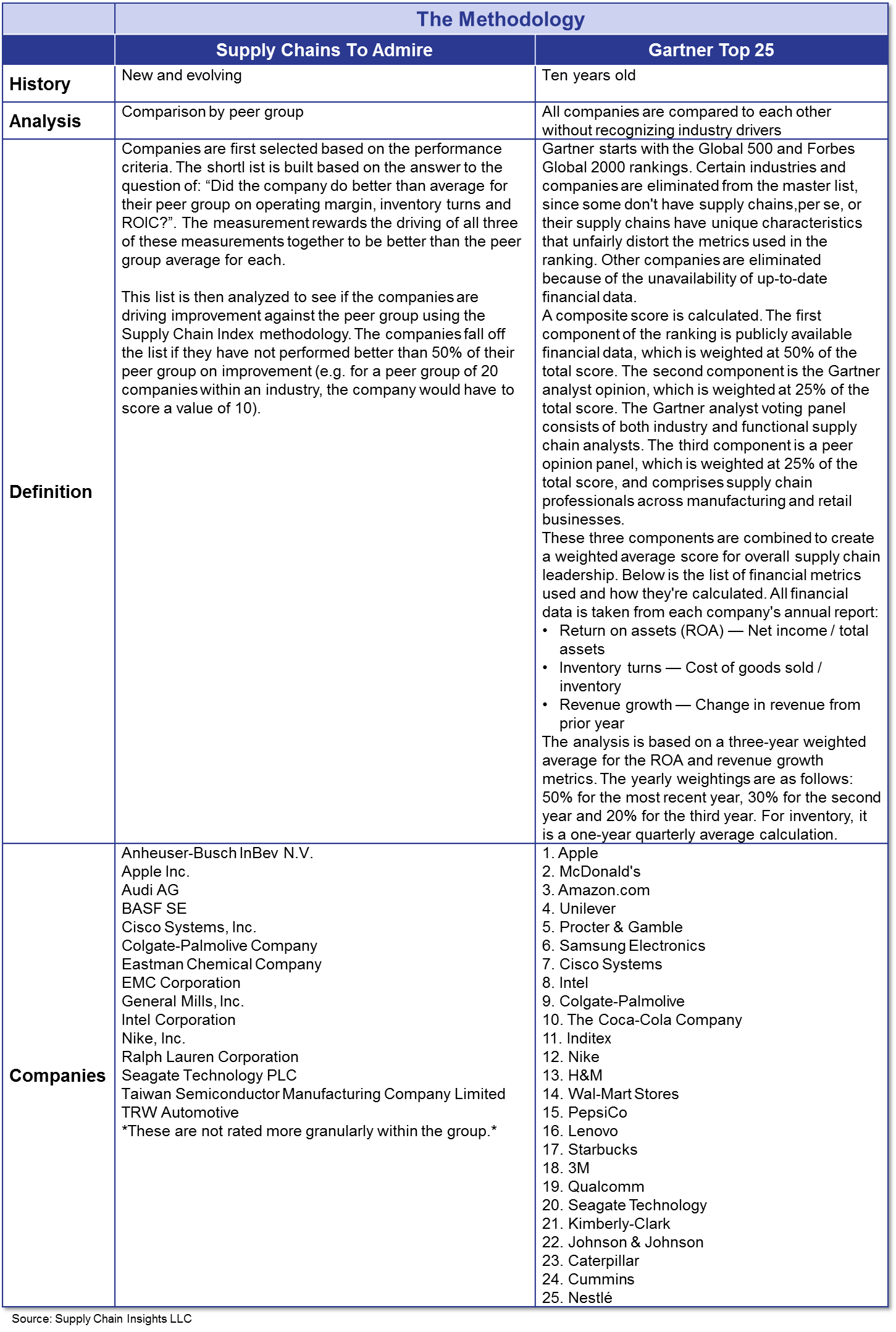Today we published a new report, Supply Chains to Admire. It is the end of a two-year research project, and identifies which publicly held companies outperformed their peer group on balance sheet results. Here we share the answers to the questions that we get the most often about this research:
What is the source of data? The data analyzed to compile the Supply Chains to Admire 2014 report came from publicly-available information from balance sheets and income statements.
Which companies were considered in the study? We built peer groups based on like industries. Companies were selected based on three criteria. They had to be publicly traded, we had to have a nearly complete data set for the years studied, and they had to have a peer group of at least six companies to be able to draw the comparisons. We eliminated several large conglomerates. As a result, you will not find 3M or GE in the data. As a result, you will not find 3M or GE in the data. This left us with a list of nearly 200 companies.
How did you define peer groups? We tried to use NAICS code designations.
If the company had multiple divisions crossing over many industries, where did you place them? We placed them in the industry that they were the most like, e.g., the primary source of revenue. For example, Johnson & Johnson has many supply chains in many industries, but the majority of the revenue comes from pharmaceuticals. As a result, we report their results along with their pharmaceutical peer group. We know that this is not perfect; but it is the best that we could do, and we think that it is a fairer comparison than putting all companies in a spreadsheet and shaking them up without any consideration for peer group analysis.
How did you select the final list of fifteen companies? The companies were selected based on performance better than peer group for 2006-2013 and delivering better than average improvement within the peer group as determined by the Supply Chain Index.
Was the list of the Supply Chains to Admire hard to select? We thought that it would be, but surprisingly it was not. After applying the rules for data collection, we ended up with 200 companies. Nineteen of the 200 companies met the performance criteria of improving operating margin, inventory turns, and ROIC together in concert for the years of 2006-2013 or 2009-2013. Four more companies fell out of the list when we applied the supply chain improvement criteria as defined by the Supply Chain Index. The companies that fell out at this point were Diageo, PepsiCo, Reckitt Benckiser, and The Gap.
How does this compare to the Gartner Top 25? One of the reasons that we built the Supply Chains to Admire is that we did not think the Gartner Top 25 serves the market well. While you need to make your own decision, here is an overview of the two methodologies:
Will you do this analysis again? Yes, we will do this study yearly in the preparation for our annual conference. This conference is designed to challenge supply chain leaders to think differently.
What is the Supply Chain Index? The Supply Chain Index is a methodology to judge supply chain improvement. It is detailed in our recent reports.
I have some input into the methodology. How do I give you feedback? We would love to hear from you either formally or informally. We get stronger through your feedback.
What did you learn?
- Despite a rise in demand and supply volatility, companies are becoming more resilient in 11 out of 15 companies studied. However, due to a variety of factors, companies are losing ground on driving progress on both inventory turns and operating margin. We believe that this is largely due to rising complexity.
- I also learned that we are not doing as well as I thought we were doing on driving balance sheet improvement. We have a lot of projects, but many companies are struggling to see these results on the balance sheet.
- I am surprised at how many companies are raising improvement in one of the three metrics, but not driving performance improvements in the total portfolio. Often, due to the lack of understanding of the supply chain as a complex system, companies will establish metric targets in isolation and throw the supply chain out of balance.

